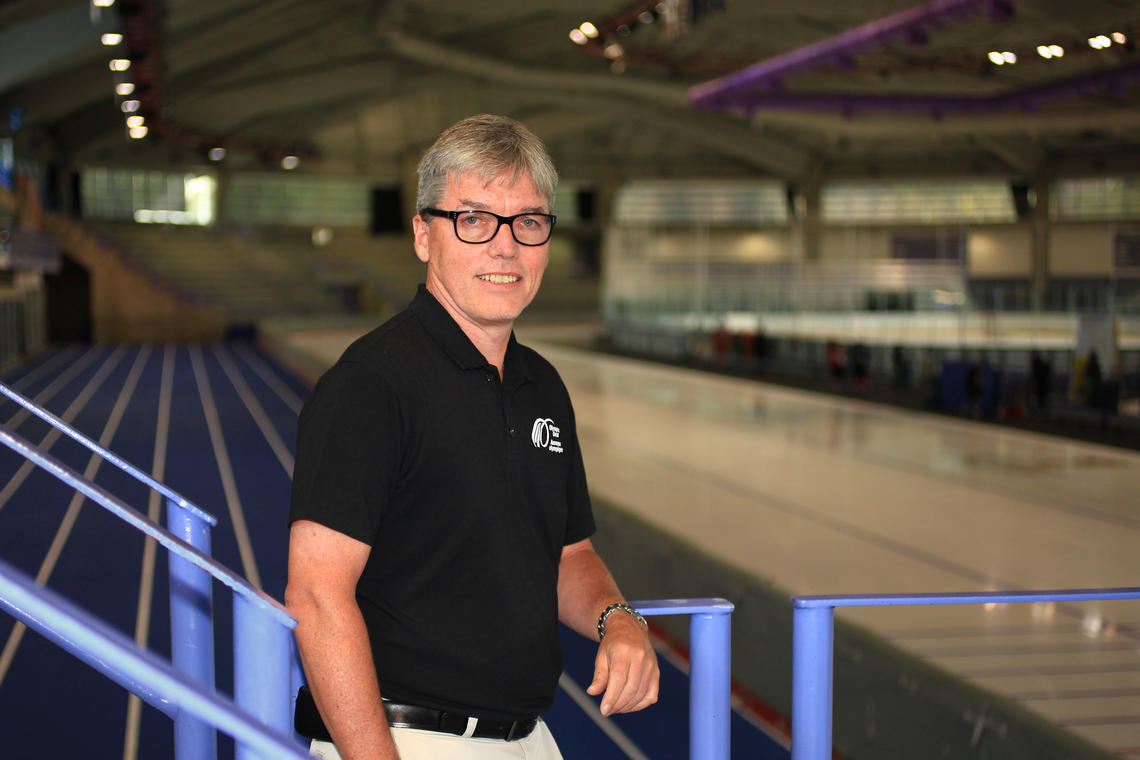
Yves Hamelin years of experience overseeing the national short-track speedskating team in Montreal.
Arno Hoogveld, University of Calgary
Aug. 11, 2014

Yves Hamelin years of experience overseeing the national short-track speedskating team in Montreal.
Arno Hoogveld, University of Calgary
It wasn’t always about sport for Yves Hamelin. The 55-year-old former resident of Montreal spent 17 years as the corporate director for Bombardier Aerospace and nine years with Pratt and Whitney Canada. A graduate of occupational hygiene at the Université du Québec à Trois-Rivières, Hamelin spent the largest part of his career as an industrial environment specialist. As he explains it, “industrial hygiene focuses on people's health within a working environment … anywhere we can see any potential hazards to their health or safety.”
He may not have known it at that moment, but this would serve as preparation to his career in speedskating and his new position as director of the University of Calgary Olympic Oval. Both instances see Hamelin following a simple mandate: Create a healthy working environment where the individual can develop and lead others toward a world-class standard.
“Most of the successes I have seen in the past are based on people,” says Hamelin during a casual interview over lunch. The conversation ranges from the deeper philosophical approach he takes in developing an organization to his season tickets to the Montreal Alouettes. Like the conversation, he is a multifaceted individual who can talk about several sides of any topic. At one point during the conversation Hamelin speaks on the theory of “sport for life,” only to follow that up by making fun of himself for no longer running at the competitive level he used to. But there is no making fun of his belief that finding the right group of individuals to work together is paramount to the actual goals of the team or organization.
“[People] are the biggest asset in an organization and everything goes to what your team believes in,” says Hamelin. “Do we have a mission? Yes, we have a direction. That needs to be clear and that needs to drive us, nothing is possible without a common value or a common goal, something that collectively we handle and we share.”
Hamelin’s philosophy on developing individuals, combined with his passion for sport, is only a small part of what has made him a great leader. For six years he coached at both the junior and senior levels and during the last eight years he played a major role as the director of the Canadian short-track team with Speed Skating Canada (SSC). During his eight years (two Olympic cycles) Hamelin helped guide the short-track team to 294 podium finishes (World Cup, world championships and Olympic competitions) and a combined eight Olympic medals in 2010 and 2014.
Among these accomplishments was the opportunity to see his son, Charles Hamelin, bring home two gold medals from the 2010 Olympic Games in Vancouver and another in the 1,500 metres in Sochi, Russia this year.
“My premier focus as a parent of athletes was to put my kids in a positive context in terms of sport being a clear addition to their lives,” says Hamelin. “My role was to help them out and find the right environment to help them grow.”
With the spotlight shifting from Russia in 2014 to the 2018 Olympics in South Korea, Hamelin takes over the Calgary role at a critical time for both SSC and the Oval. His experience and expertise will allow him to remain a part of the SSC program but with a broader reach and control of Canada’s premier speedskating venue.
Despite his connections to the highest levels of the sport, Hamelin sees the Oval as being a truly multifaceted venue. One of the keys for the facility remains an integration of the three legacy agreement pillars and other business partners — high performance, the public and the University of Calgary (varsity programs and Active Living). There is an emphasis by Hamelin on finding a balance for all these groups with particular attention to the public and the community.
“We need to be seen in the community as a place that families can access and offer the opportunity for their children to interact in our environment,” says Hamelin as he gestures out his window toward a crowd of young Oval summer speed camp participants. “It’s in the summer weeks now, when I see 800 kids running around campus for summer camps and I see 120 kids here actually skating for a training camp. It’s all a good demonstration of how we are meeting our objective.”
Hamelin believes that this ideal of grassroots growth for the sport is the basis for success in the future. It is through accessibility to a world-class facility like the Oval that members of the public find their way to speedskating. The result is a positive alignment with the Oval’s high-performance program.
“The difference-maker will be how good we are going to be at aligning the pathway for kids from their early start through their various stages of development,” says Hamelin, still motioning to the crowd of young skaters. “If we create that, I have no doubt that the future with be better and we’ll create what everyone in Calgary and in Canada expects to see from us. It’s helping the athletes achieve their best level, represent Canada and win medals at the end."